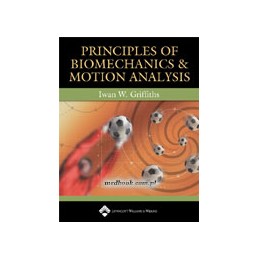- Obniżka


 Dostawa
Dostawa
Wybierz Paczkomat Inpost, Orlen Paczkę, DHL, DPD, Pocztę, email (dla ebooków). Kliknij po więcej
 Płatność
Płatność
Zapłać szybkim przelewem, kartą płatniczą lub za pobraniem. Kliknij po więcej szczegółów
 Zwroty
Zwroty
Jeżeli jesteś konsumentem możesz zwrócić towar w ciągu 14 dni*. Kliknij po więcej szczegółów
This text offers a practical approach to biomechanics and motion analysis by illustrating mechanical and mathematical principles with real-world examples. The book explains the principles of mechanics and covers all aspects of kinematics and kinetics.
Basic principles are illustrated with actual data obtained in laboratory settings. Case studies in each chapter present real situations to provide a deeper understanding of the principles. Each chapter ends with study questions. Mathematics is restricted to the essentials and many advanced calculations are performed using spreadsheet calculations. More than 250 illustrations complement the text.
Opis
Chapter 1. Scalar Quantities and Vector Quantities in Biomechanics
1.1 Scalars and Vectors
1.2 Addition of Scalars
1.3 Addition of Vectors
1.4 Parallelogram Rule
1.5 Resolution of Vectors into Components
1.6 Unit Vectors I, J, K
1.7 Scalar Products of Two Vectors
1.8 Vector Products of Two Vectors
Chapter 2. Linear Kinematics
2.1 The Law of Inertia
2.2 Methods of Measuring an Objects Speed or Velocity
2.3 Graphical Means of Deriving Velocity
2.4 Equations for Speed and Velocity
2.5 Acceleration as the Slope of V-T Graph
2.6 Frames of Reference
2.7 Projectiles
Chapter 3. Equilibrium
3.1 The Effect of Friction
3.2 Moments of Forces
3.3 Parallel Forces
3.4 Centre of Gravity
3.5 Couples
3.6 Bodies at Rest
3.7 Equilibrium Under the Action of Two Forces
3.8 The Centre of Mass of a Stationary Body
3.9 Equilibrium Under the Action of Three Forces
3.10 Hydrostatics and Flotation
Chapter 4. Motion in a Straight Line (Dynamics I)
4.1 Inertia and Mass
4.2 Force
4.3 Newtons First Law
4.4 Gravitational Forces
4.5 Newtons Second Law
4.6 The Acceleration due to Gravity and Weight
4.7 Newtons Third Law
4.8 Friction
4.9 The Momentum of a Body
4.10 Projectile Motion Taking into Account The Drag Force
Chapter 5. Dynamics
5.1 Work Done by a Constant Force
5.2 Work Done by a Variable Force
5.3 Kinetic Energy
5.4 Gravitational Potential Energy
5.5 Conservation of Energy
5.6 Power
5.7 Impulsive Forces
5.8 Collisions in One Dimension
5.9 Conservation of Momentum
5.10 Elastic and Inelastic Collisions
5.11 Springs and Hookes Law
5.12 Oscillatory Motion
Chapter 6. Motion in a Circle (Angular Kinetics)
6.1 Angular Displacement, Velocity, and Acceleration
6.2 Absolute Angles and Relative Angles
6.3 Calculation of Angular Information from (X, Y) Coordinate Data
6.4 Important Equations in Angular Kinematics
Chapter 7. Angular Dynamics
7.1 Angular Motion Vectors
7.2 Torque
7.3 Rotational Inertia
7.4 Easy Ways to Find the Moment of Inertia
7.5 Angular Momentum
7.6 Angular Kinetic Energy
Chapter 8. Calculations Using Text or ASCII Files
8.1 Text Files
8.2 Coordinate-Time Data
8.3 Obtaining Velocities and Accelerations
8.4 Noise and Smoothing
Chapter 9. Mechanical Analyses
9.1 The Camera System
9.2 Force Plates and Additional Sensors
9.3 Standing Long Jump
9.4 High Jump
9.5 Running
Chapter 10. Analysis of Specialized Movement Patterns Using Vicon
10.1 Golf
10.2 Gymnastics
10.3 Football
Indeks: 16078
Autor: Prof. dr Gerald Huther
Naukowo udowodniony sposób na zdrowie i długowieczność
